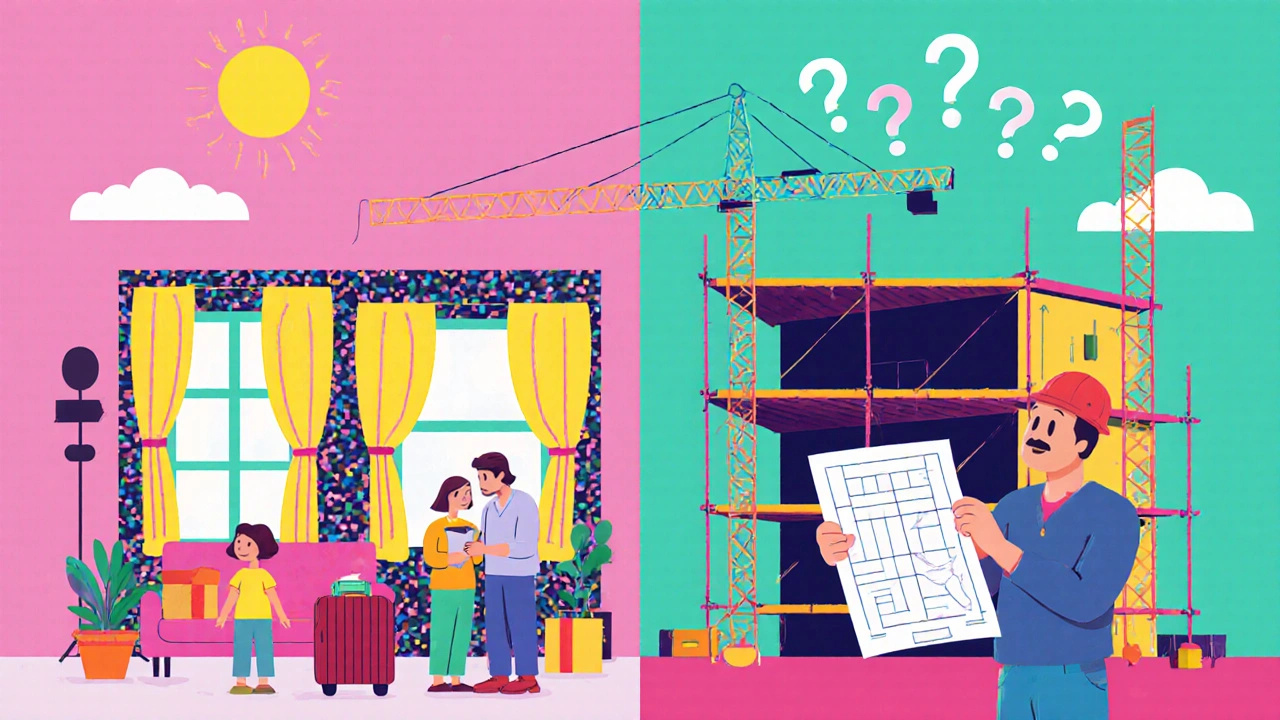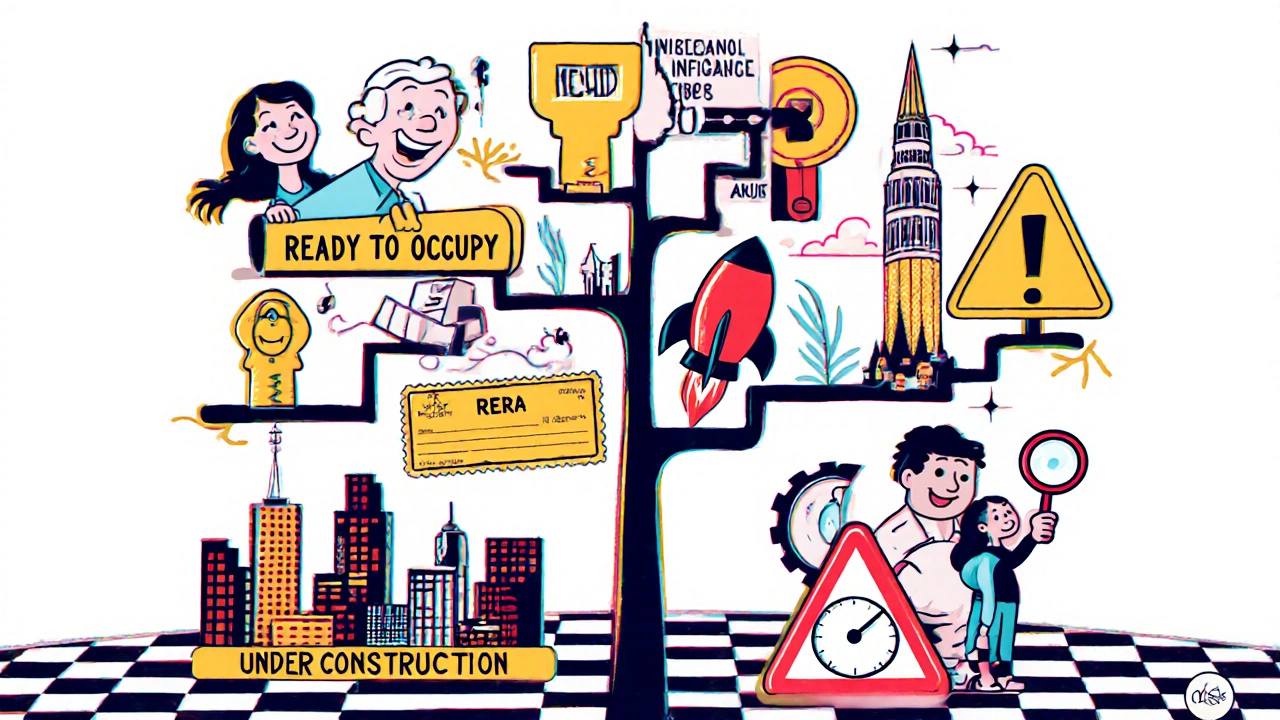Ready-to-Occupy vs Under-Construction Property in India: Which Is Better for Buyers?
 Nov, 23 2025
Nov, 23 2025
When you’re thinking about buying property in India, you’re not just picking a home-you’re making a financial decision that could shape your future. Two main options stand out: ready-to-occupy property and under-construction property. Each has real pros and cons, and choosing the wrong one can cost you time, money, or both.
What Does Ready-to-Occupy Really Mean?
A ready-to-occupy property is exactly what it sounds like: the building is done, the keys are ready, and you can move in within days. No waiting. No dust. No uncertainty about whether the balcony will actually be built.
In cities like Bangalore, Pune, or Hyderabad, these homes are often part of completed residential complexes with functional amenities-swimming pools, gyms, security systems, and even kids’ play areas. You can walk through the unit, check the paint quality, test the water pressure, and see how the sunlight hits the living room at 4 p.m. That kind of certainty matters.
Buyers who are relocating for work, retiring, or planning to rent out the property immediately prefer this option. If you’re buying for rental income, a ready unit can start earning from day one. There’s no gap between purchase and income. No lost rent while waiting for construction to finish.
But here’s the catch: you pay more. Ready-to-occupy properties typically cost 15-25% more than similar units under construction. Why? Because the developer’s risk is gone. You’re paying for completion, not potential.
Under-Construction: The Gamble with High Rewards
Under-construction properties are bought before the building is finished. You sign the agreement, pay a portion upfront, and make payments in stages as construction hits milestones-foundation, slab, plaster, finishing.
This option is popular among younger buyers, investors, and those with tight budgets. In Mumbai and NCR, you can get a 2BHK in an under-construction project for ₹60-70 lakhs, while the same unit in a ready building might cost ₹85 lakhs or more.
The biggest advantage? Lower upfront cost and potential for capital appreciation. If you buy in a growing area like Greater Noida, Faridabad, or Kalyan, and the area develops over 2-3 years, your property’s value could jump 30-50%. That’s not speculation-it’s what happened in Gurgaon between 2019 and 2023. Buyers who invested early saw their units appreciate by nearly 40% by the time handover happened.
But here’s where things get risky. Delays are common. A 2024 report by the National Housing Bank found that 37% of under-construction projects in Tier-1 cities were delayed by more than 12 months. Some developers run out of cash. Others face legal issues with land titles. And if the project is registered under RERA, you have some protection-but enforcement isn’t always quick.
Also, you can’t see what you’re buying. Floor plans look good on paper, but the actual layout might feel cramped. The promised clubhouse might become a storage room. The promised view? Blocked by a new building next door.
Cost Breakdown: Upfront vs Long-Term Expenses
Let’s compare two 2BHK apartments in Pune, both in the same locality:
| Feature | Ready-to-Occupy | Under-Construction |
|---|---|---|
| Price per sq.ft | ₹12,500 | ₹9,200 |
| Total price (900 sq.ft) | ₹1.12 crore | ₹82.8 lakh |
| Down payment (20%) | ₹22.4 lakh | ₹16.6 lakh |
| EMI start date | Immediate | After possession (18-30 months later) |
| Registration + stamp duty | ₹5.6 lakh | ₹4.1 lakh |
| Interest paid during construction | ₹0 | ₹3.2-4.5 lakh (on pre-EMI) |
| Estimated appreciation (3 years) | 5-8% | 30-50% |
At first glance, the under-construction option saves you ₹30 lakh upfront. But you’re also paying interest during construction-called pre-EMI-on the portion of the loan disbursed so far. That adds up. And if the project is delayed, you’re stuck paying both rent and pre-EMI for months longer than expected.
With ready-to-occupy, you pay more now, but you avoid the hidden costs. No pre-EMI. No delays. No surprises. You know exactly what you’re getting.

Who Should Buy Ready-to-Occupy?
If you fall into any of these categories, go for ready-to-occupy:
- You’re moving to India from abroad and need a home fast.
- You’re retiring and want stability, not stress.
- You plan to rent it out and need immediate income.
- You’ve been burned by delays before and don’t want to risk it again.
- You’re not comfortable with uncertainty-especially when it involves your life savings.
These buyers value peace of mind over potential gains. And that’s completely valid. Real estate isn’t just an investment-it’s your shelter.
Who Should Go for Under-Construction?
Under-construction makes sense if:
- You’re young, have time to wait, and can afford to carry two costs (rent + pre-EMI) for a few years.
- You’re buying purely as an investment and believe the area will grow fast.
- You’re okay with doing your own due diligence-checking RERA registration, builder track record, and past project delays.
- You want customization options (floor plan changes, tile colors, fixtures) that aren’t available in ready units.
But here’s a hard truth: not every under-construction project pays off. Only builders with a proven history of on-time delivery-like Lodha, Godrej Properties, or Prestige-deserve your trust. Avoid unknown developers, even if they offer 10% lower prices.

Red Flags to Watch For
Whether you’re buying ready or under-construction, watch out for these warning signs:
- No RERA registration number on the website or sales brochure.
- Builder asks for large upfront payments without a signed agreement.
- Project has no clear timeline or milestones.
- Previous projects by the same builder have long delays or legal issues.
- Land title is unclear-ask for the original sale deed and encumbrance certificate.
- No physical site visit allowed, or the site looks abandoned.
Always verify RERA registration on your state’s official portal. In Maharashtra, go to mahaRERA.gov.in. In Karnataka, it’s kararera.karnataka.gov.in. Don’t rely on what the sales agent tells you.
Final Decision: It’s Not About Price-It’s About Your Life Stage
There’s no one-size-fits-all answer. The right choice depends on your situation, not just the numbers.
If you need a home now, or if you can’t afford to wait, go for ready-to-occupy. You’ll sleep better knowing your keys are in hand.
If you’re patient, financially flexible, and believe in long-term growth, under-construction can give you a bigger return. But only if you pick the right builder and location.
Don’t let FOMO push you into a bad deal. Don’t let low prices blind you to risk. Real estate in India isn’t a lottery. It’s a long-term commitment. Choose wisely.
Is it safe to buy under-construction property in India?
Yes, but only if you verify RERA registration, check the builder’s track record, and avoid projects with a history of delays. RERA gives buyers legal protection, but enforcement varies by state. Always get a copy of the agreement and confirm the builder has completed at least three previous projects on time.
Can I get a home loan for under-construction property?
Yes, most banks and NBFCs offer home loans for under-construction properties. The loan is disbursed in stages as construction progresses. You pay only pre-EMI (interest on disbursed amount) until possession. After handover, full EMI starts. Make sure your lender is experienced with RERA-compliant projects.
Do ready-to-occupy properties have better resale value?
Generally, yes. Ready properties attract more buyers because there’s no waiting. Buyers looking to move in quickly prefer them. In cities like Delhi and Mumbai, ready units often sell 10-15% faster than under-construction ones. But if the under-construction project is in a high-growth zone, its appreciation may outpace ready units over 5+ years.
What’s the average delay for under-construction projects in India?
According to the National Housing Bank’s 2024 report, the average delay for under-construction projects in Tier-1 cities is 14 months. In Tier-2 cities, delays average 10 months. Around 1 in 3 projects miss their deadline by over a year. Always build a 6-12 month buffer into your timeline.
Should I buy a ready property in a new area or wait for construction to finish?
Buy ready only if the area already has infrastructure-roads, schools, hospitals, public transport. If the area is still developing, buying under-construction gives you a better price and lets you ride the growth wave. But make sure the developer has a clear plan for amenities and connectivity. Don’t buy into a ghost town.
